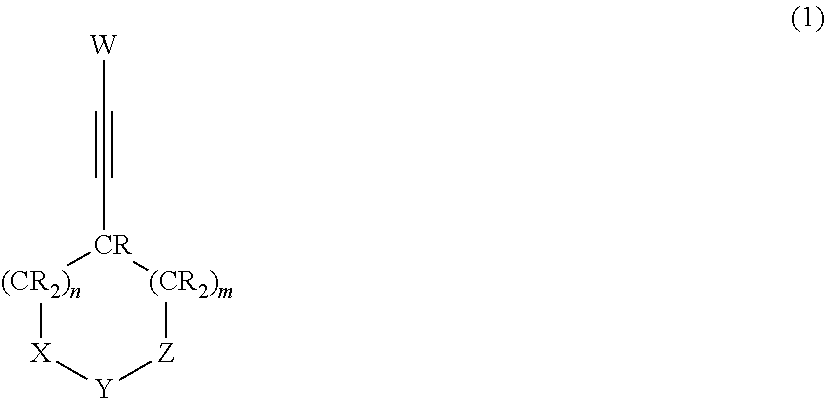Nonaqueous electrolytic solution and nonaqueous electrolyte secondary battery
- Summary
- Abstract
- Description
- Claims
- Application Information
AI Technical Summary
Benefits of technology
Problems solved by technology
Method used
Image
Examples
examples
[0358]The present invention will be explained in more detail next based on examples and comparative examples. However, the present invention is not limited to these examples.
[0359]
[0360]The compound represented by formula (1) used in the present examples was synthesized according to the method described below.
[0361](Synthesis of Compound I)
[0362]Starting material 1) was synthesized in accordance with the method of Non-Patent Document (Journal of Organic Chemistry, 56(3), 1083-1088 (1991)). Next, compound I was obtained in accordance with the method set forth in Non-Patent Document (European Journal of Organic Chemistry, 2009(20), 2836-2844), using the starting material 1).
[0363](Synthesis of Compound II)
[0364]Under a nitrogen stream, starting material 1) was dissolved in methylene chloride, and a methylene chloride solution of starting material 3) was dripped. After 3 hours of stirring at room temperature, water was added to stop the reaction, and the organic layer was washed with s...
example a
[0368](Production of a Negative Electrode)
[0369]A slurry was formed by adding 100 parts by weight of an aqueous dispersion of sodium carboxymethyl cellulose (concentration of sodium carboxymethyl cellulose 1 wt %), and 2 parts by weight of an aqueous dispersion of styrene-butadiene rubber (styrene-butadiene rubber concentration 50 wt %), as a thickener and a binder, respectively, to 98 parts by weight of a carbonaceous material, with mixing in a disperser. The obtained slurry was coated onto a 10 μm-thick copper foil, was dried, and was rolled using a press. The rolled product was cut to a shape having a width of 30 mm and a length of 40 mm, as the size of the active material layer, and having an uncoated portion having a width of 5 mm and a length of 9 mm, to yield a negative electrode that was used in Examples 1 to 4, Comparative examples 1 to 3 and Reference example 1.
[0370](Production of a Positive Electrode)
[0371]A slurry was formed by mixing, in an N-methylpyrrolidone solvent,...
example b
[0384](Production of a Positive Electrode)
[0385]A slurry was formed by mixing, in an N-methylpyrrolidone solvent, 90 wt % of LiCoO2, as a positive electrode active material, 5 wt % of acetylene black, as a conductive material, and 5 wt % of polyvinylidene fluoride, as a binder. The obtained slurry was applied onto a 15 μm-thick aluminum foil, was dried, and was rolled using a press. The rolled product was cut to a shape having a width of 30 mm and a length of 40 mm, as the size of the active material layer, and having an uncoated portion having a width of 5 mm and a length of 9 mm, to yield a positive electrode that was used in Examples 5 to 17 and Comparative examples 4 to 7.
[0386](Production of an Electrolyte Solution)
[0387]A base electrolyte solution was prepared by dissolving dried LiPF6 in a mixture of monofluoroethylene carbonate and dimethyl carbonate (volume ratio 30:70), to a proportion of 1 mol / L, in a dry argon atmosphere. The compounds set forth in Table 3 were mixed int...
PUM
 Login to View More
Login to View More Abstract
Description
Claims
Application Information
 Login to View More
Login to View More - R&D
- Intellectual Property
- Life Sciences
- Materials
- Tech Scout
- Unparalleled Data Quality
- Higher Quality Content
- 60% Fewer Hallucinations
Browse by: Latest US Patents, China's latest patents, Technical Efficacy Thesaurus, Application Domain, Technology Topic, Popular Technical Reports.
© 2025 PatSnap. All rights reserved.Legal|Privacy policy|Modern Slavery Act Transparency Statement|Sitemap|About US| Contact US: help@patsnap.com



